The Iridescent Shark (Pangasius hypophthalmus) known to tropical fish keeping enthusiasts as the Mystic Shark, Sutchi Catfish, Pangasius Cat, ID Shark, or Striped Catfish is found in large rivers in the Mekong, Maeklong, and Chao Phraya river basins of Southeast Asia.
The Iridescent Shark (Pangasius hypophthalmus) is a migratory species (both a spawning and a trophic) that brings the fish into the floodplain areas of Cambodia and Viet Nam.
As the waters in the Mekong Delta flood from May to July, they leave the main river and move upstream to spawn. As the waters recede from September thru December, they return to their mainstreams. The downstream migration in Cambodia and farther south in Viet Nam takes palce from May to August
From March to August, the presence of eggs in females from Stung Treng to Kandal confirms the downstream migration as both a spawning and a trophic migration. They are so abundant in the lower Mekong in Cambodia and Viet Nam that juveniles are collected for rearing in floating fish cages by locals in the rice fields and floodplain.
Because of the glittery silver coloration as juveniles, Iridescent Sharks (Pangasius hypophthalmus) are commonly sold to tropical fish keeping enthusiasts in the aquarium trade, however, it is a large catfish species that quickly outgrows it’s surroundings. In the west, adult Iridescent Sharks are sold as a food fish called Swai in the USA.
Juvenile Iridescent Sharks (Pangasius hypophthalmus) have a brilliant glittery silver body color with two dark lateral stripes along the sides and a white belly. Their silver gray fins are lined dark black. As they grow, the stripes disappear and the body color changes into a dark gray with a white belly. Juvenile males have darker stripes and are more slender than females.
An albino variant is also available to tropical fish keeping enthusiasts.
The Iridescent Shark (Pangasius hypophthalmus) should not be confused with it’s larger cousin Pangasius sanitwongsei commonly called the Paroon Shark, Giant Pangasius, Chao Phraya Giant Catfish, Pla Tepa, Emperor ID Shark, Hi-Fin Shark, or Hi-Fin Bull Shark.
Pangasius sanitwongsei grow to almost 10 feet in length and have pointed, more elongated dorsal and caudal fins. Pangasius hypopthalmus max out at a little over 4 feet in length and have rounded, more blunt dorsal and caudal fins.
Iridescent Sharks are an active, peaceful but skittishly nervous species that prefers to live in groups, especially as juveniles. They are easily startled and will jump out of the water when spooked.
Although not recommended for home aquariums, juvenile Iridescent Sharks should be housed in groups of 5 or more individuals in at least a 350 gallon aquarium with a fine gravel or sand substrate, a few smooth river rocks, and a piece or two of driftwood. They do not require a lot of water movement but need a secure lid, dim lighting, and an extremely efficient filtration system. Regular water changes are also required to maintain water quality.
As juveniles they can be housed with a variety of species in a community environment, but as they grow, they should not be kept with smaller fish that they could fit into their mouths. Suitable tank mates include other iridescent sharks, catfish, Plecostomus, silver dollars, cichlids, and fire eels.
Pangasius hypophthalmus are commercially farmed in large ponds and not commonly bred in an aquarium environment.
In their natural environment, Iridescent Sharks are omnivores that feed on worms, crustaceans, insects, fish, plants, benthic algae, and other organic matter. In addition to a high quality omnivore flake food, juveniles in an aquarium environment need more meat in their diet such as live, frozen, or freeze dried bloodworms, mysis shrimp, shrimp, brine shrimp, feeder fish, crickets, earthworms
, etc.
As they grow into adulthood, they lose their teeth and require a more vegetarian diet of algae flakes, peas, etc. in addition to their juvenile diet of live food.
Iridescent Shark (Pangasius hypophthalmus) are commonly sold and are readily available as juveniles at reasonable prices to tropical fish keeping enthusiasts online and from local fish shops.
Minimum Tank Size: 350 gallons
Care Level: Difficult
Temperament: Peaceful
Aquarium Hardiness: Hardy
Water Conditions: 72-79°F, 2-29 °d, pH 6.4 – 7.5
Max. Size: 4 feet
Color Form: Silver Black, White
Diet: Omnivore
Compatibility: Shoaling, Community
Origin: Southeast Asia
Family: Pangasiidae
Lifespan: 8-20 years
Aquarist Experience Level: Advanced

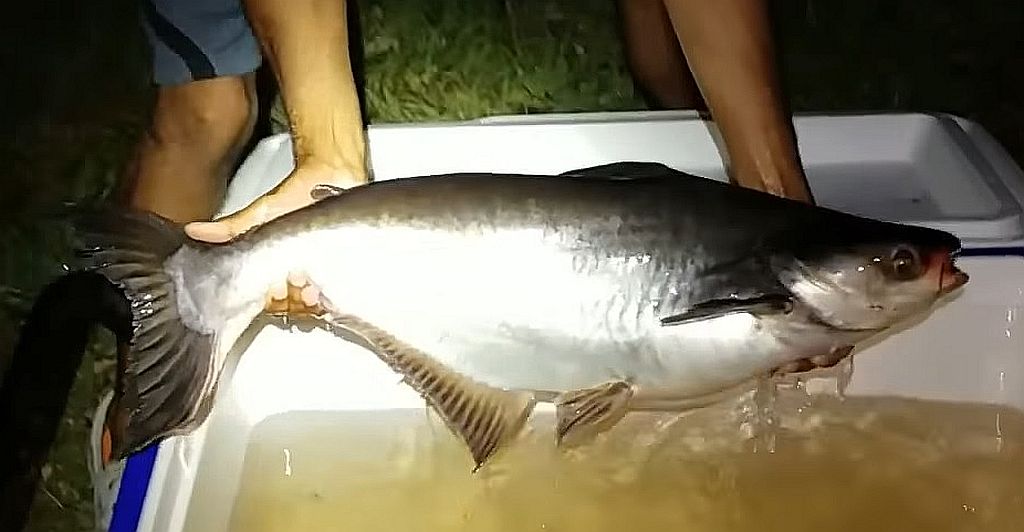
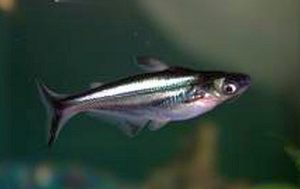
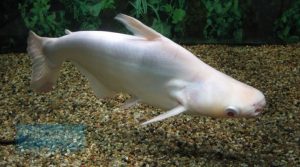
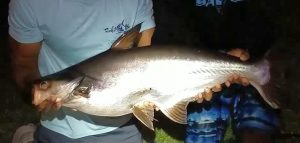
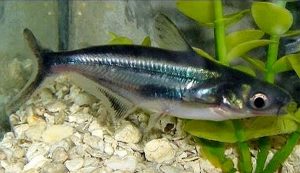

One Response to “Iridescent Shark (Pangasius hypophthalmus)”
Trackbacks/Pingbacks
[…] feet in length and have pointed, more elongated dorsal and caudal fins than Iridescent Sharks. Iridescent Sharks (Pangasius hypopthalmus) max out at a little over 4 feet in length and have rounded, more blunt dorsal and caudal […]